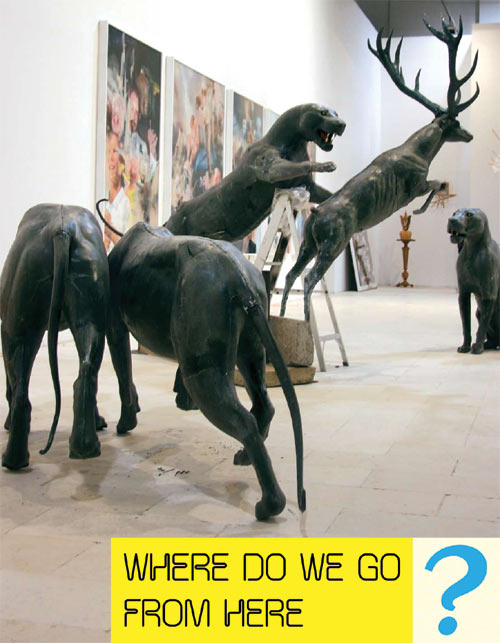

Phileleftheros publisher Nicos Chr Pattichis is exhibiting works from his personal collection and that of the newspaper for the first time. The exhibition is being held at the invitation of the Nicosia Municipal Art Centre in cooperation with the Pierides Foundation, within the framework of the programme “Under construction: Alternative Museum Spaces”.
WHERE DO WE GO FROM HERE?
Works from the collections of Nicos Chr. Pattichis and Phileleftheros.
«? whatever the orientation of a collection, it will always embody an irreducible element of independence from the world? Indeed we are bound to ask: can objects ever institute themselves as a viable language? Can they ever be fashioned into a discourse otherwise than toward onself?», Jean Baudriallard, The System of Collecting
Even though serious private collections are destined eventually to enter into a dialogue with the public space, a private collection, whatever its content, usually remains for years behind closed doors, strictly inaccessible, a feast for the eye that is enjoyed by the collector. As Baudrillard says, collecting as a practice symbolises independence from the world. The collector aims to create a private universe to which he dedicates himself with passion and enthusiasm, and to which access to third parties is not always envisioned.
Even though serious private collections are destined eventually to enter into a dialogue with the public space, a private collection, whatever its content, usually remains for years behind closed doors, strictly inaccessible, a feast for the eye that is enjoyed by the collector. As Baudrillard says, collecting as a practice symbolises independence from the world. The collector aims to create a private universe to which he dedicates himself with passion and enthusiasm, and to which access to third parties is not always envisioned.
This decision to escape from the sphere of the private and enter that of the public, taking on an active role in curating the exhibition, marked a significant change as regards the collector’s position vis a vis his collection and his presence in Cyprus’ artistic world. It is significant that on the occasion of the exhibition he has commissioned some of the more active Cypriot artists to create pieces specially for the collections. Socratis Socratous, Panayiotis Michail, Polis Peslikas, Lefteris Tapas, Phanos Kyriakou, Demetris Neocleous, Savvas Christodoulides and Nicos Charalambides are currently working feverishly creating their work, giving the exhibition that we will see in May another dimension and proving that the more interesting collections are never a finished affair, but yet another open procedure which is constantly on-going.
Even though he considers himself a collector in the strict sense of the term, Nicos Pattichis shares the key characteristic of a man who has dedicated himself to the process of active and selective acquisition of objects: The passion for what he collects: In this particular case, the passion for contemporary art. This passion has led to the ‘hunt’ for works of art, a process which intrigues him, offering a sense of satisfaction. Equally distinctive is the collector’s dedication to what he does; not its collectors’ value or its position on the stock exchange of art. What drives him is the impulse to make what he admires his, the enthusiasm for what he loves. It is to this that the definition of object used by Baudrillard in his essay “anything which is the cause or subject of a passion. Figuratively and most typically: the loved object”. Perhaps that is why for Nicos Pattichis, his relationship with a work of art he is about to acquire has the dimension of love at first sight. “The work that I will buy is that which I fell in love with at first sight,” he says in his first interview.
However, as he has demonstrated many times, history of art and the cultural significance of the works are not restricted to the narrow confines of a personal wish. The activities of the systematic collector exercise influence not only the way we perceive, understand and exhibit art, but the way artists produce art. One such example is Charles Saatchi, who despite his controversial tactics, played a leading role in promoting contemporary British art. Another example closer home is the case of Dakis Ioannou, who through the activities of the DESTE Foundation, introduced the Athens public to the contemporary artistic scene. Nicos Pattichis’ influence in the development of Cyprus art has still not been assessed; this exhibition may serve as the occasion for this. But the indications are there. His decision to become actively involved in artistic production, commissioning new works is one such indication, as is the fact that his collection currently numbers some of the most important works of the artistic world of the island in the past 20 years. The Guide by Angelos Makrides, The Birthday Party (1972) by Glyn Hughes or Veroniki or The Absent One (2000) from the cycle Promise by Lefteris Olympiou are all key works in the artistic progress of their creators and demonstrate the collector’s systematic contact with Cyprus’ artistic reality. They are also indicative of the direction of his private collection. The core is made up of works that are vivid and anthropocentric and which underline his lively interest in an art sensitive to the human form at its most unaffected and existential moments. This interest is not restricted to Cyprus. The collection also has works from Greece, such as the newly-acquired Spaceship Columbia, 2006 by Yiannis Varelas. The same applies also to the Phileleftheros collection even though, as this is a historic newspaper, this also features works with political ramifications which refer to the history of the country, the central part being Invitation(1974) by Greek artist Demetris Alithinos.
It is these works of art that we will have a chance to see in the exhibition which the collector is preparing in May under the title “Where do we go from here?” This question is immediate and clear, giving the whole venture another dimension. The exhibition ceases to operate as a simple presentation of acquisitions of a private collector and aspires to constitute a launching pad for a wider debate on the current Cypriot artistic and political and social world. With Ledra Street opening for the first time in 45 years, Cyprus society is at a crossroads. There is a lot we need to decide. There are a lot of questions to which we must give definitive answers. What kind of solution do we aspire to in our political problem? What kind of concessions are we prepared to make? How do we move on from here? Where do we go from here? We are at a crossroad in relation to culture. Two years after the cancellation of the Manifesta, we are experiencing a period of stagnation with significant infrastructural projects still on paper or forgotten in government drawers, with many remarkable artists restricted to conventional forms of action, as they face the indifference not only of the state but of the private sector. The question therefore remains the same, and in fact poses itself more urgently that ever. Where do we go from here? At the same time this query appears to be directed to the collector himself as well. The exhibition of his collection to the public for the first time constitutes a big landmark in its course from which, in order to move forward, he too will have to give an answer to the question that he has posed. Once more therefore: Where do we go from here?
Elena Parpas
Editor, Isterografo, Phileleftheros
Nicosia Municipal Art Centre, in cooperation with the Pierides Foundation
Under construction: Alternative Museum Spaces”.
Organisers:
Nicosia Municipal Art Centre, Pierides Foundation, Chamber of Fine Arts (EKATE) , Πολιτιστικές Υπηρεσίες του
Cultural Servicies of the Ministry of Education and Culture.
Curated / setting up of exhibition: Nicos Chr. Pattichis
Some of the artists whose works will be exhibited are:
Demetris Alithinos, Michalis Arfaras, Yiannis Varelas, Costis Georgiou, Anastasia Douka, Haris Epaminonda, Glafcos Koumides, Phanos Kyriakou, George Lapas, Maria Loizidou, Angelos Makrides, Michalis Manousakis, Panayiotis Michail, Demetris Neocleous, Lefteris Olympios, Pavlos, Maria Perendou, Polis Peslikas, Lefteris Tapas, Zenonas Tzembras, Hurig Torossian, Costas Tsoklis, Nicos Charalambides, Glyn Hughes, Savvas Christodoulides, Ian Dawson.

 Gracing the interior of Omikron Gallery were 230 pashminas which well known personalities from Cyprus and Greece had at the invitation of Myrna Pattichis and after several weeks of inspiration and creativity, turned into superb women’s accessories. Kiosks with various sweets, food and drink for young and old were set up outside. In a relaxed, celebratory atmosphere, away from the fast pace of everyday life, people had the opportunity to take a stroll with their families and enjoy with their children the live link from Kiss FM, a magician’s show, excerpts from the successful theatre performance, “The Yourouniasmata”, songs from the Musical Workshop of Yiorgos Theophanous, dance from the Motion Art Studio group and an impressive dance show from Ricardo Cuellar Barrios, who inspired participants to keep beat to the catchy zumba rhythms.
Gracing the interior of Omikron Gallery were 230 pashminas which well known personalities from Cyprus and Greece had at the invitation of Myrna Pattichis and after several weeks of inspiration and creativity, turned into superb women’s accessories. Kiosks with various sweets, food and drink for young and old were set up outside. In a relaxed, celebratory atmosphere, away from the fast pace of everyday life, people had the opportunity to take a stroll with their families and enjoy with their children the live link from Kiss FM, a magician’s show, excerpts from the successful theatre performance, “The Yourouniasmata”, songs from the Musical Workshop of Yiorgos Theophanous, dance from the Motion Art Studio group and an impressive dance show from Ricardo Cuellar Barrios, who inspired participants to keep beat to the catchy zumba rhythms.





 A charity event organised by Phileleftheros and
A charity event organised by Phileleftheros and  The auction started at 8:00 pm and ended a little before midnight to great success. All 138 bags were sold, raising close to €60,000. Present at the event was Cypriot star singer Anna Vishi who not only made two of the wonderful bags but sang during the event. The Kiondo baskets are made in Nyeri, the roads of which are full of women balancing them on their heads to carry their shopping, their laundry for washing to the closest stream, or even their children.
The auction started at 8:00 pm and ended a little before midnight to great success. All 138 bags were sold, raising close to €60,000. Present at the event was Cypriot star singer Anna Vishi who not only made two of the wonderful bags but sang during the event. The Kiondo baskets are made in Nyeri, the roads of which are full of women balancing them on their heads to carry their shopping, their laundry for washing to the closest stream, or even their children.






 With half a century of responsibility on its shoulders, Phileleftheros can boast that it has fulfilled its promise: To serve the people of Cyprus. Beginning as a daily newspaper in the second half of the century, it must build on its contribution to culture which is the most significant foundation for the national and physical survival of the people of Cyprus in the new conditions of co-habitation in Europe. Culture is the unerring compass of a society as it transforms the present into a hopeful future, making the best of the legacy of the past.
With half a century of responsibility on its shoulders, Phileleftheros can boast that it has fulfilled its promise: To serve the people of Cyprus. Beginning as a daily newspaper in the second half of the century, it must build on its contribution to culture which is the most significant foundation for the national and physical survival of the people of Cyprus in the new conditions of co-habitation in Europe. Culture is the unerring compass of a society as it transforms the present into a hopeful future, making the best of the legacy of the past.








